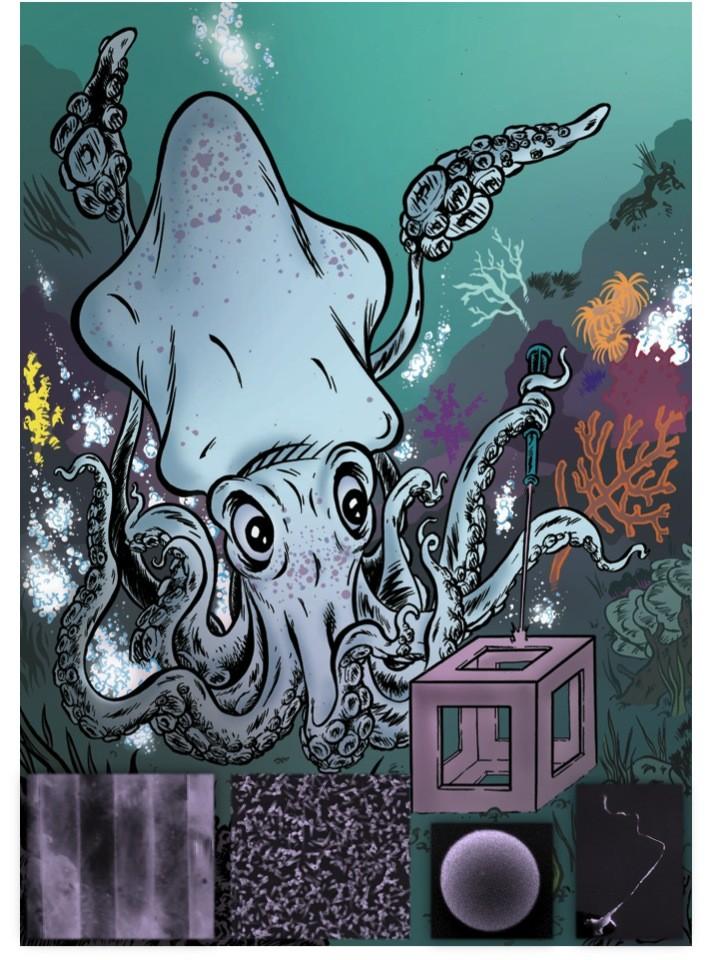Thermoplastics are fairly ubiquitous in the 3D printing space. As with any plastic material, though, they have always been subject to environmental concerns; how easy are they to produce, to use, to dispose of? What effects can this have on the environment? Will they maintain integrity if made with bio-based materials?
Some materials that have eco-conscious sources have been hit-or-miss. In a new development out of Penn State University, it looks like  researchers have hit upon the latest “hit” for a viable thermoplastic material for 3D printing and it comes… from a squid?
researchers have hit upon the latest “hit” for a viable thermoplastic material for 3D printing and it comes… from a squid?
That’s right, squids, those massive denizens of the deep, have more to offer than just calamari and ink: utilizing a protein complex found in the squid ring teeth (SRT), the blueprint to a naturally occurring thermoplastic material can be found.
Professor of Engineering Science and Mechanics Melik C. Demirel headed up a team looking into the cephalopods’ genetic sequencing. The research received further support from the Office of Naval Research and the Army Research Office. Other members of the team included Abdon Pena-Francesch, Huihun Jung, Sergio Florez, Aswathy Sebastian, and Istvan Albert.
As Demirel points out, “Most of the companies looking into this type of material have focused on synthetic plastics. Synthetic plastics are not rapidly deployable for field applications, and more importantly, they are not eco-friendly.”
Starting with the European common squid, Demirel and his team examined the SRT protein complex; they have six squids’ genetic sequences collected already and are on track to utilize their information to synthesize a thermoplastic. Their results-to-date have recently been published in Advanced Functional Materials.
Thermoplastics are an important material in the 3D printing world due to their structural stability; they can be melted, formed, and re-solidified without degradation to their properties. Fossil fuels currently form the foundation for most  thermoplastics made, and it’s pretty widely known that these materials are simply not going to last forever. By sourcing thermoplastics from renewable sources, there’s a brighter — and far more sustainable — future for 3D printing of complex geometric forms.
thermoplastics made, and it’s pretty widely known that these materials are simply not going to last forever. By sourcing thermoplastics from renewable sources, there’s a brighter — and far more sustainable — future for 3D printing of complex geometric forms.
The SRT contain a protein complex with a pressure sensitive adhesion characteristic that lends itself to uses in 3D shaping. The elastomeric protein complex can be shaped into films, ribbons, and other 3D forms.
The smallest known molecular weight SRT protein, which is a thermoplastic, can be fabricated and used in a few different ways. By inserting SRT proteins into E. coli, researchers can utilize recombinant techniques to synthesize this small SRT molecule. The thermoplastic is created by the normal activity sprung from the combination of E. coli and the SRT molecule, after which it is removed from that media. For this portion of the research, Demirel and his team collaborated with Professor of Chemical Engineering Wayne Curtis.
“Direct extraction or recombinant expression of protein based thermoplastics opens up new avenues for materials fabrication and synthesis, which will eventually be competitive with the high-end synthetic oil based plastics,” said the researchers’ report.
From their work, the Penn State team have created a semi-crystalline thermoplastic material. It can be made in either a soft or a rigid form, and has a wet adhesive and a high tensile strength. It can be customized to fit the needs of different projects, including medical and cosmetic uses — e.g., dental resins, bandages, and internal surgical sutures. The thermoplastic is a protein, which makes it suitable for such adaptations.
“The next generation of materials will be governed by molecular composition — sequence, structure and properties,” said Demirel.
Through use of the synthesized protein from the SRT complex, the researchers may be on to the next big thing in eco-friendly thermoplastics. Let us know what you think of their work at the Squid Protein-Based Thermoplastic for 3D Printing forum thread over at 3DPB.com.
Subscribe to Our Email Newsletter
Stay up-to-date on all the latest news from the 3D printing industry and receive information and offers from third party vendors.
You May Also Like
Profiling a Construction 3D Printing Pioneer: US Army Corps of Engineers’ Megan Kreiger
The world of construction 3D printing is still so new that the true experts can probably be counted on two hands. Among them is Megan Kreiger, Portfolio Manager of Additive...
US Army Corps of Engineers Taps Lincoln Electric & Eaton for Largest 3D Printed US Civil Works Part
The Soo Locks sit on the US-Canadian border, enabling maritime travel between Lake Superior and Lake Huron, from which ships can reach the rest of the Great Lakes. Crafts carrying...
Construction 3D Printing CEO Reflects on Being Female in Construction
Natalie Wadley, CEO of ChangeMaker3D, could hear the words of her daughter sitting next to her resounding in her head. “Mum, MUM, you’ve won!” Wadley had just won the prestigious...
1Print to Commercialize 3D Printed Coastal Resilience Solutions
1Print, a company that specializes in deploying additive construction (AC) for infrastructure projects, has entered an agreement with the University of Miami (UM) to accelerate commercialization of the SEAHIVE shoreline...































